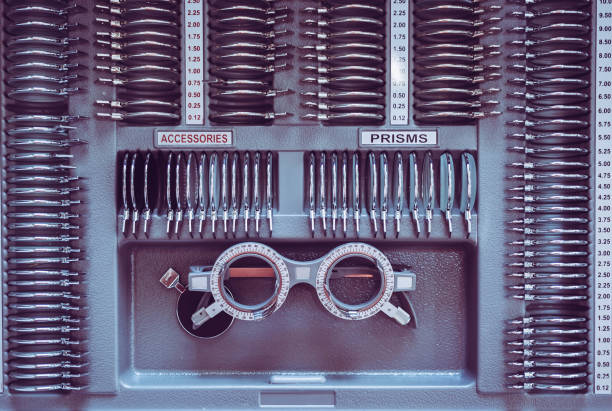
Guide to Picking Glasses That Suit Your Face Shape Perfectly
February 27,2023

What is Boho Style? A Comprehensive Guide to Boho-Chic Fashion
February 13,2025

Virtual Glasses Try On - Find Your Perfect Pair Online
April 02,2024

UV Protection Glasses VS. Blue Light Glasses - Vooglam
July 20,2023

Newest Style Modern Trendy Mens Glasses | Vooglam
March 01,2024

Stylish Reading Glasses: Blending Fashion with Functionality
February 16,2023

What are photochromic lenses & glasses?
September 22,2023

Brown Eyes: The Beauty of the Most Common Hue
September 01,2024

The chubby face glasses for round face female
August 02,2023

What are prisms in eyeglasses?
March 20,2023

What are Bifocal Lenses? - Vooglam
April 14,2023

How to Read Your Eyeglass Prescription?
March 11,2023
What are progressive multifocal lenses?
Progressive multifocal lenses are also called progressive addition lenses, progressive power lenses, or progressive prescription lenses. It refers to the eyewear lens with multiple focal points, which blends near, distance, and mid-distance focus points. Wearing premium progressive lenses helps the wearer see clearly at any viewing distance without the need to change glasses.

Progressive multifocal lenses are the new trend
The most common lenses are single-focal lenses with only one diopter on the lenses. Moreover, many elderly people wear bifocal lenses to solve the problem of seeing far and near at the same time. However, when wearing bi-focal lenses, visual distortion or blurring may occur in areas where the focus is switched. Also due to the disadvantage of limited applicability, fewer and fewer people are wearing bifocal glasses. This page on progressive lenses vs. bifocals explains that progressive multifocal addition lenses are a new development in the history of lens development.

Progressive multifocal lenses are multi-useful
Progressive multifocal lenses have different zones of vision from top to bottom on the front side. The seamless connection between each visual field makes it seem easier for the wearer to see objects at near, far, and intermediate distances. At the same time, the wearer can read or use the computer, or do driving and outdoor activities without having to change to another pair of glasses.

The first appearance of progressive multifocal lenses
In 1907, Irving Avis first introduced the concept of progressive multifocal lenses, marking the birth of a new concept in vision correction. The design of this special progressive addition lens was inspired by the shape of an elephant trunk. Progressive lenses have a progressive zone on the surface of the lens, located between the distance and near zones. In this zone, the lens gradually changes focus and transitions from distance to near vision to provide mid-distance vision. In this zone, the lens gradually changes focus and transitions from distance to near vision to provide mid-distance vision correction.

Further popularity of multifocal lenses
On the basis of the previous ideas, with the help of new achievements in design and development provided by modern technology, in 1951, the Frenchman Meitnaz designed the first progressive multifocal lens with a modern concept, which can be used for clinical wearing. After several improvements, it was first put on the French market in 1959. Its innovation in the concept of visual correction has won the attention of the world, and it was soon extended to the European continent and North America.

With the development of computers, the application of advanced design software and instruments to the design and development of spectacle lenses has made a huge development in the design of progressive lenses. Design and development of formula, asymmetric, aspheric far view zone. Progressive addition lenses have undergone several major innovations, the types of lenses are increasing, and the wearer of progressive lenses is growing.
The original design of progressive multifocal lenses
The original intention of progressive multifocal lenses is to provide a natural, convenient, and comfortable correction method for presbyopia patients. Wearing multifocal addition lenses is like taking pictures with a camera. A pair of glasses can see both far and near clearly. Objects at medium distances can be seen clearly. So we describe progressive lenses as "zoom lenses", and wearing a pair of glasses is equivalent to using more glasses. Progressive lenses are therefore an alternative to bifocal or trifocal lenses to correct refractive errors such as presbyopia (farsightedness that develops with age and is a common problem in people over 40).

The main types of progressive prescription lenses in recent years
In recent years, progressive multifocal lenses have shown extremely rapid development and popularization. Nowadays, scientists have made corresponding research on multifocal addition lenses according to the eye use and physiological characteristics of people of different ages, and finally divided them into three categories:
- 1. Adolescent myopia control lenses - Used to reduce visual fatigue and control the speed of myopia development;
- 2. Anti-fatigue lenses for adults - Used for teachers, doctors, and people who use too many computers at close range, to reduce visual fatigue at work;
- 3. Progressive lenses for elderly people - a pair of glasses for elderly people to easily see farsightedness and nearsightedness.
Progressive multifocal addition lenses' cost & price
Generally speaking, the production cost of progressive lenses will be relatively high, because it is a kind of functional glasses lenses. The main factors that determine the cost and price of progressive lenses are:
Lens material
As a rule of thumb, the thinner and lighter the lens, the more expensive it is usually. It is important to note that the best progressive lenses are made using digital freeform techniques, more in the design part of the process.
Progressive lenses are made of plastic polymers. For example, CR-39 is for weaker prescriptions. High refractive index plastic polymers are used for stronger prescriptions, allowing for higher density and thinner lenses and enhanced visual clarity.
Lens design
Progressive lenses have complex designs due to the inclusion of multiple optical powers, and vary in the size of the transition channel, the smoothness of the transition between optical powers, and the time it takes to adjust to the frame, all of which affect cost. Progressive addition lenses are designed with smooth transitions and relatively short adjustment times in mind.
Coating
Lenses can be upgraded with a variety of coatings. The most popular types of coatings are anti-scratch (protects the lens), anti-reflection (reduces glare), and UV protection (protects against UV rays). The more advanced the type of coating, the more expensive the final price of the lens will be.
Some disadvantages of progressive addition lenses
Of course, there is a downside to the function of progressive addition lenses instead of eye adjustment, and that is lens dependence. If you wear progressive lenses for a long time, the adjustment function of the eye and the ability to gather will be weakened if you do not get exercise. If there is no regulation or weak regulation, the following problems will occur, such as looking close without glasses or wearing regular glasses. After taking off the progressive glasses, the eyes are sore and swollen, so please do not wear them for a long time if possible.

Therefore, no matter what job you are in, or the scene, it is best to keep the awareness of glasses protection. If there is a problem with your eyesight, you need to go to the doctor for an examination in time, get a valid prescription for yourself, and then get the correct glasses. If there is astigmatism, blurred vision, etc., progressive prescription lenses are very suitable for this condition.

Vooglam Blog
Vooglam blog shares professional knowledge about eyeglass frames, lenses, etc., and provides help when purchasing and using eyewear products. At the same time, Vooglam focuses on fashion glasses to interpret the trend of glasses for you.

































